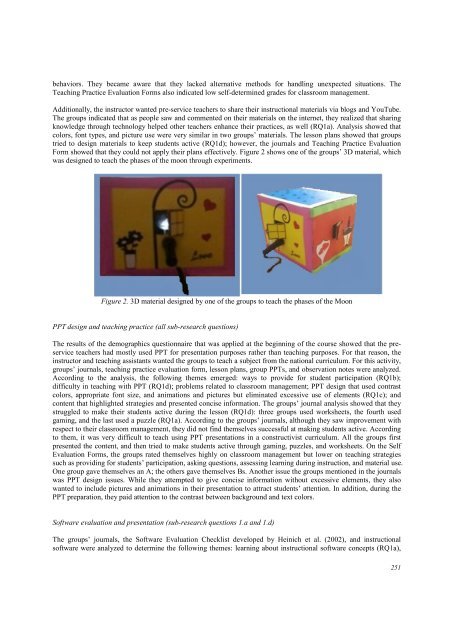Download Complete Issue in PDF - Educational Technology & Society
Download Complete Issue in PDF - Educational Technology & Society
Download Complete Issue in PDF - Educational Technology & Society
You also want an ePaper? Increase the reach of your titles
YUMPU automatically turns print PDFs into web optimized ePapers that Google loves.
ehaviors. They became aware that they lacked alternative methods for handl<strong>in</strong>g unexpected situations. The<br />
Teach<strong>in</strong>g Practice Evaluation Forms also <strong>in</strong>dicated low self-determ<strong>in</strong>ed grades for classroom management.<br />
Additionally, the <strong>in</strong>structor wanted pre-service teachers to share their <strong>in</strong>structional materials via blogs and YouTube.<br />
The groups <strong>in</strong>dicated that as people saw and commented on their materials on the <strong>in</strong>ternet, they realized that shar<strong>in</strong>g<br />
knowledge through technology helped other teachers enhance their practices, as well (RQ1a). Analysis showed that<br />
colors, font types, and picture use were very similar <strong>in</strong> two groups’ materials. The lesson plans showed that groups<br />
tried to design materials to keep students active (RQ1d); however, the journals and Teach<strong>in</strong>g Practice Evaluation<br />
Form showed that they could not apply their plans effectively. Figure 2 shows one of the groups’ 3D material, which<br />
was designed to teach the phases of the moon through experiments.<br />
Figure 2. 3D material designed by one of the groups to teach the phases of the Moon<br />
PPT design and teach<strong>in</strong>g practice (all sub-research questions)<br />
The results of the demographics questionnaire that was applied at the beg<strong>in</strong>n<strong>in</strong>g of the course showed that the preservice<br />
teachers had mostly used PPT for presentation purposes rather than teach<strong>in</strong>g purposes. For that reason, the<br />
<strong>in</strong>structor and teach<strong>in</strong>g assistants wanted the groups to teach a subject from the national curriculum. For this activity,<br />
groups’ journals, teach<strong>in</strong>g practice evaluation form, lesson plans, group PPTs, and observation notes were analyzed.<br />
Accord<strong>in</strong>g to the analysis, the follow<strong>in</strong>g themes emerged: ways to provide for student participation (RQ1b);<br />
difficulty <strong>in</strong> teach<strong>in</strong>g with PPT (RQ1d); problems related to classroom management; PPT design that used contrast<br />
colors, appropriate font size, and animations and pictures but elim<strong>in</strong>ated excessive use of elements (RQ1c); and<br />
content that highlighted strategies and presented concise <strong>in</strong>formation. The groups’ journal analysis showed that they<br />
struggled to make their students active dur<strong>in</strong>g the lesson (RQ1d): three groups used worksheets, the fourth used<br />
gam<strong>in</strong>g, and the last used a puzzle (RQ1a). Accord<strong>in</strong>g to the groups’ journals, although they saw improvement with<br />
respect to their classroom management, they did not f<strong>in</strong>d themselves successful at mak<strong>in</strong>g students active. Accord<strong>in</strong>g<br />
to them, it was very difficult to teach us<strong>in</strong>g PPT presentations <strong>in</strong> a constructivist curriculum. All the groups first<br />
presented the content, and then tried to make students active through gam<strong>in</strong>g, puzzles, and worksheets. On the Self<br />
Evaluation Forms, the groups rated themselves highly on classroom management but lower on teach<strong>in</strong>g strategies<br />
such as provid<strong>in</strong>g for students’ participation, ask<strong>in</strong>g questions, assess<strong>in</strong>g learn<strong>in</strong>g dur<strong>in</strong>g <strong>in</strong>struction, and material use.<br />
One group gave themselves an A; the others gave themselves Bs. Another issue the groups mentioned <strong>in</strong> the journals<br />
was PPT design issues. While they attempted to give concise <strong>in</strong>formation without excessive elements, they also<br />
wanted to <strong>in</strong>clude pictures and animations <strong>in</strong> their presentation to attract students’ attention. In addition, dur<strong>in</strong>g the<br />
PPT preparation, they paid attention to the contrast between background and text colors.<br />
Software evaluation and presentation (sub-research questions 1.a and 1.d)<br />
The groups’ journals, the Software Evaluation Checklist developed by He<strong>in</strong>ich et al. (2002), and <strong>in</strong>structional<br />
software were analyzed to determ<strong>in</strong>e the follow<strong>in</strong>g themes: learn<strong>in</strong>g about <strong>in</strong>structional software concepts (RQ1a),<br />
251

















